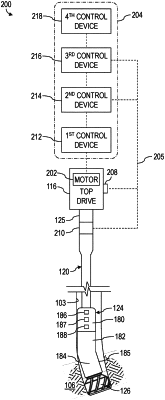| CPC E21B 44/04 (2013.01) [E21B 3/02 (2013.01); E21B 7/068 (2013.01)] | 17 Claims |

|
9. A method comprising:
commencing operation of a processing device to determine a reference rotational distance of a top drive to be utilized during slide drilling, wherein the processing device:
outputs a first control command to cause the top drive to rotate a drill string; and
determines the reference rotational distance based on rotational distance measurements indicative of rotational distance achieved by the top drive and torque measurements indicative of torque applied to the drill string by the top drive, wherein the rotational distance measurements are obtained via a rotation sensor, and the torque measurements are obtained via an electrical device; and
during the slide drilling, the processing device outputs second control commands to cause the top drive to alternatingly rotate the drill string in opposing first and second rotational directions based on the reference rotational distance, wherein the second control commands cause the top drive to:
during the slide drilling as initiated after pumping drilling fluid through the drill string to operate a mud motor of the drill string to rotate a drill bit of the drill string and going on bottom of a wellbore with the drill bit at an intended rate of penetration or hook load, rotate to an initial rotational position;
then rotate from the initial rotational position in the first rotational direction based on the reference rotational distance;
then rotate in the second rotational direction to the initial rotational position;
then rotate from the initial rotational position in the second rotational direction based on the reference rotational distance; and
then rotate in the first rotational direction to the initial rotational position.
|